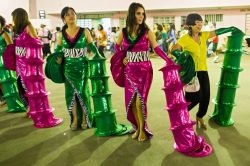Japan designer lends style to Brazil Carnival group

The Osaka-born stylist, world famous for designing costumes for operas and uniforms for sports teams and corporations, is usually more at ease in the upscale fashion circles of Paris, Beijing or New York.
But there she was last Wednesday night, hobnobbing with the humble denizens of Jabaquara, a working-class Sao Paulo district.
After a warm welcome from school members and the local Japanese community, she got down to business and joined in the last rehearsal before Barroca steps into the Sambodrome, Sao Paulo’s samba parade ground.
Created in 1974 and officially known as Faculdade do Samba, Barroca will be the last of 12 schools competing in the weakest field of the Sao Paulo carnival, which kicked off Friday.
The first two top finishers in the group will graduate to a more competitive group next year.
Speaking through an interpreter, the 73-year-old Koshino explained why she came here to help.
« I chose to help Barroca because it was the first samba school which introduced a Japanese wing (a component of the performance) in Brazil, » she told AFP. « It’s a way to say thank you, to give back. »
Barroca this year is focusing its carnival theme on the history of Jabaquara, an ethnically diverse district that includes Jardim Oriental, a community that is home to many Japanese.
Barroca spokeswoman Rosa Maria Gomes de Oliveira explained that the aim was to celebrate the area’s various ethnic communities, including Afro-Brazilians, Spaniards, Germans and Japanese.
« I am responsible for supervising the Jardim Oriental wing of the (samba) school, which will feature a colorful fantasy allegory representing contemporary Japan, the Japan of the future, » Koshino said.
Her aide, Eliza Ohtsuka, explained that the wing would feature 90 members dressed in white and black kimono-style costumes.
Other members will parade in pink and green outfits with folding lanterns of matching colors, she added.
During the parade, the samba schools are judged in several categories — including theme, costumes and overall organization — during their 45-minute pass through the Sambodrome.
De Oliveira said Koshino had long wanted to do a documentary on the Brazilian carnival.
« But she did not want to focus on an elite carnival, a carnival with lots of sponsors. She wanted a carnival rooted in a real community, » she said.
« She came to Brazil in November, discovered our school and began working on a documentary. »
At the rehearsal held in a community center tucked away under an expressway, Koshino led members in an elaborate dance carrying pink and green folding lanterns similar to those used in Japan on festive occasions.
A Japanese television crew was present to shoot a documentary about her and Barroca.
Although she thought her charges were not « very well coordinated, » she quickly added that she had no doubt that they would put on a « solid performance. »
Barroca is not, however, competing in the elite group reserved for Sao Paulo’s top 14 samba schools, which paraded their lavishly decorated floats and beauty queens at the 30,000-seat Sambodrome Friday and Saturday.
« We are not a rich school and only survive thanks to donations, members’ contributions and help from the community, » said de Oliveira.
By contrast, Koshino, whose two sisters Hiroko and Michiko are also well-known fashion designers, is an international celebrity, with boutiques in Paris, New York, Beijing and Singapore.
She said she developed a strong bond with the Barroca school and with the local Japanese community.
Brazilians of Japanese ancestry currently number 1.8 million, or a little over one percent of the country’s total population.
Around 60 percent of them live in Sao Paulo state, with other major concentrations in the states of Parana and Matto Grosso.

